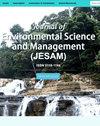生活在边缘:苏禄珍稀特有鸟类的现状
IF 0.3
4区 环境科学与生态学
Q4 ENVIRONMENTAL SCIENCES
Journal of Environmental Science and Management
Pub Date : 2020-07-16
DOI:10.47125/jesam/2019_sp1/01
引用次数: 0
摘要
苏禄群岛由数百个岛屿组成,拥有独特而独特的特有鸟类动物群。由于岛屿面积相对较小和森林砍伐迅速,许多这些物种面临灭绝的危险。苏禄群岛的一些特有鸟类已经几十年没有在野外观察到,可能已经在没有人注意到的情况下灭绝了。本研究利用现有资料描述了该地区特有鸟类的现状。由于在该地区进行的科学调查很少,因此大多数信息都是从参观该地区的观鸟者的轶事报告中收集的。所有苏禄特有的鸟类都依赖于森林,被世界自然保护联盟列为濒危物种红色名录。一个多世纪以来,苏禄人的流血心脏加利科伦巴都没有被记录下来。苏禄犀鸟在野外可能只剩下20对,除了名字和叫声之外,关于苏禄犀鸟的信息也不多了。迅速消失的森林,加上狩猎和采矿,使苏禄群岛成为该国最优先保护的地点之一。苏禄群岛不仅位于菲律宾的地理边缘,而且也是独特物种濒临灭绝的地方。迫切需要立即对苏禄群岛的鸟类多样性进行就地保护和全面调查。本文章由计算机程序翻译,如有差异,请以英文原文为准。
Living on the Edge: Current Status of Rare Sulu Endemic Avifauna
The Sulu Archipelago, consisting of hundreds of islands, harbors unique and distinct endemic avian fauna. Due to the relatively small size of the islands and the rapid deforestation, many of these species are in danger of extinction. Some of the endemic bird species in the Sulu Archipelago have not been observed in the wild for decades and may already have gone extinct without being noticed. This study uses available information to describe the current status of endemic bird species in the area. Most of the information were gathered from anecdotal reports of birdwatchers who visited the area since very few scientific surveys have been done there. All of the Sulu endemic bird species are forest dependent and categorized as threatened on the IUCN Red List. The Sulu Bleeding-heart Gallicolumba menagei has not been recorded for over a century. The Sulu Hornbill Anthrococeros montani may have no more than 20 pairs left in the wild and not much more is known of the Sulu Hawk-Owl Ninox reyi apart from its name and call. The rapidly disappearing forests, combined with hunting and mining, make the Sulu Archipelago arguably one of the highest priority sites for conservation in the country. The Sulu Archipelago is not only located at the geographical edge of the Philippines, but it is also where unique species are on the edge of extinction. Immediate in situ conservation and comprehensive surveys of the avifaunal diversity in the Sulu Archipelago are urgently needed.
求助全文
通过发布文献求助,成功后即可免费获取论文全文。
去求助
来源期刊

Journal of Environmental Science and Management
ENVIRONMENTAL SCIENCES-
CiteScore
0.90
自引率
0.00%
发文量
10
审稿时长
2 months
期刊介绍:
The Journal of Environmental Science and Management (JESAM) is an international scientific journal produced semi-annually by the University of the Philippines Los Baños (UPLB).
JESAM gives particular premium to manuscript submissions that employ integrated methods resulting to analyses that provide new insights in environmental science, particularly in the areas of:
environmental planning and management;
protected areas development, planning, and management;
community-based resources management;
environmental chemistry and toxicology;
environmental restoration;
social theory and environment; and
environmental security and management.
 求助内容:
求助内容: 应助结果提醒方式:
应助结果提醒方式:


